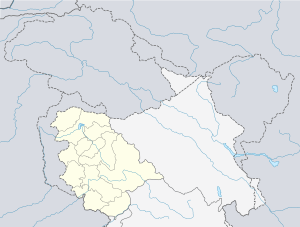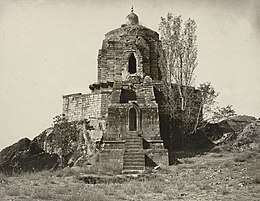Shankaracharya Temple
The Shankaracharya Temple is also known as the Jyeshteshwara Temple. It is situated on top of the Shankaracharya Hill on the Zabarwan Range in Srinagar, Jammu and Kashmir, India. It is dedicated to Lord Shiva. The temple is at a height of 1,000 feet (300 m) above the valley floor and overlooks the city of Srinagar.
| Shankaracharya Temple | |
|---|---|
.jpg) Shankaracharya temple | |
| Religion | |
| Affiliation | Hinduism |
| Deity | Shiva |
| Location | |
| Location | Srinagar |
| State | Jammu and Kashmir |
| Country | India |
 Location in Jammu and Kashmir  Shankaracharya Temple (India) | |
| Geographic coordinates | 34°4′44″N 74°50′37″E |
| Elevation | 1,852.16 m (6,077 ft) |
History and development

Photos taken in 1868 CE by John Burke (photographer)
The temple may date to c. 200 BC although the present structure probably dates to the 9th century AD. It was visited by Adi Shankara and has ever since been associated with him; this is how the temple got the name Shankaracharya. It is also regarded as sacred by Buddhists.[1] Some historians report that the temple was actually a Buddhist temple during the Buddhist era which was then changed into Hindu site of worship by Adi Shankaracharya.
According to Pandit Anand Koul (1924) the temple was originally built by a Hindu king "Sandiman" who, according to Koul, reigned in Kashmir from 2629 to 2564 BC.[1] It was repaired by King Gopaditya (426–365 BC) and by King Lalitaditya (697–734 A.D.).[1] Sikandar, the iconoclast did , for some reason, destroy it. Zain-ul-Abidin repaired its roof which had tumbled down by earthquake. Sheikh Ghulam Mohi-ud-din, a Sikh Governor (1841–46), also repaired its dome.
The earliest historical reference to the hill comes from Kalhana. He called the mountain Gopadri. Kalhana says that King Gopaditya granted the land at the foot of the hill to the Brahmins that had come from the "Araya versh." The land grant was called "GOPA AGRAHARAS". This area is now called Gupkar. Kalhana mentions another village in the vicinity of the hill. King Gopaditya housed some of the Brahmins to a village next door. Kalhana names this village as Bhuksiravatika (Buch’vore today). Kalhana also mentions that King Gopaditya built the temple on the top of the hill as a shrine to Jyesthesvara (Shiva Jyestharuda) around 371 BC.[2]
The Dogra King Gulab Singh (1846-1857 AD) constructed the steps to the hill from Durga Naag temple side. The Maharaja of Mysore came to Kashmir in 1925 and he made the electrical installations at the temple. In 1961 Shankaracharaya of Dwarkapeetham put the statue of Adi Shankaracharaya in the temple. In 1974 the Government of J&K constructed the road that goes to the TV antenna near the top of the hill.[3]
Soundarya Lahari
Kashmir is believed to be the seat of Shaivam, the Himalaya Mountains and Sri Kailashagiri as "The massed laughter of Sri Shiva." It was from here that the sweet nectar of Shiva's devotion spread in India and around the globe, by the spiritual works of saints like Adi Shankaracharya. Soundarya Lahari was composed by Adi Shankara atop the Gopadari Hill, after accepting the fact that the union of Sri Shiva and Devi Shakti, as in Shaktism, transpired into the Shakti-Shri Chakra, the symbol of Devi (Goddess), as Sri Yantra, as mentioned in 'Shankara Digvijay' - Life history of Shankaracharya,[4] and only when Shiva is united with Shakti does he have the power to create.[5]
Architecture and design
The Jyoteshware temple rests on a solid rock. A 20-foot tall octagonal base supports a square building on top. The terrace around the square temple is reached by a stone staircase enclosed between two walls. A doorway on the opposite side of the staircase leads to the interior, which is a small and dark chamber, circular in plan. The ceiling is supported by four octagonal columns, which surround a Basin containing a Lingam encircled by a snake.
Current status
.jpg)
The temple is used for regular worship and pilgrims visit the temple during the Amarnath Yatra.[6]
Visitor information
There are 243 steps leading up to the temple area and another 8-10 steps from there to the temple hall. Entrance to the hill is guarded by army personnel and cars are not permitted after 17:00 hours, although the temple remains open until 20:00 hours. Views of Srinagar are possible from the top of the hill.
References
- Jammu, Kashmir and Ladakh: Tourist Guide. Anmol Publications Pvt. Limited. 1989. ISBN 9788171580149.
- Kalhana's Rajtarangni A Chronicle of Kings of Kasmir Volume II by M.A. Stein Published by Motilal Banarsidas Reprint 1979 Page 453
- Kashur Encyclopedia Volume one Published by Jammu & Kashmir Academy of Art Culture and Languages, Srinagar 1986 Page 302
- Sankara Digvijaya: The Traditional Life of Sri Sankaracharya
- Adi Shankracharya's Visit to Kashmir
- "Amarnath Pilgrims reach Shankaracharya Temple". Hindustan Times. 22 July 2009. Retrieved 7 December 2013.
External links
| Wikimedia Commons has media related to Shankaracharya Temple. |